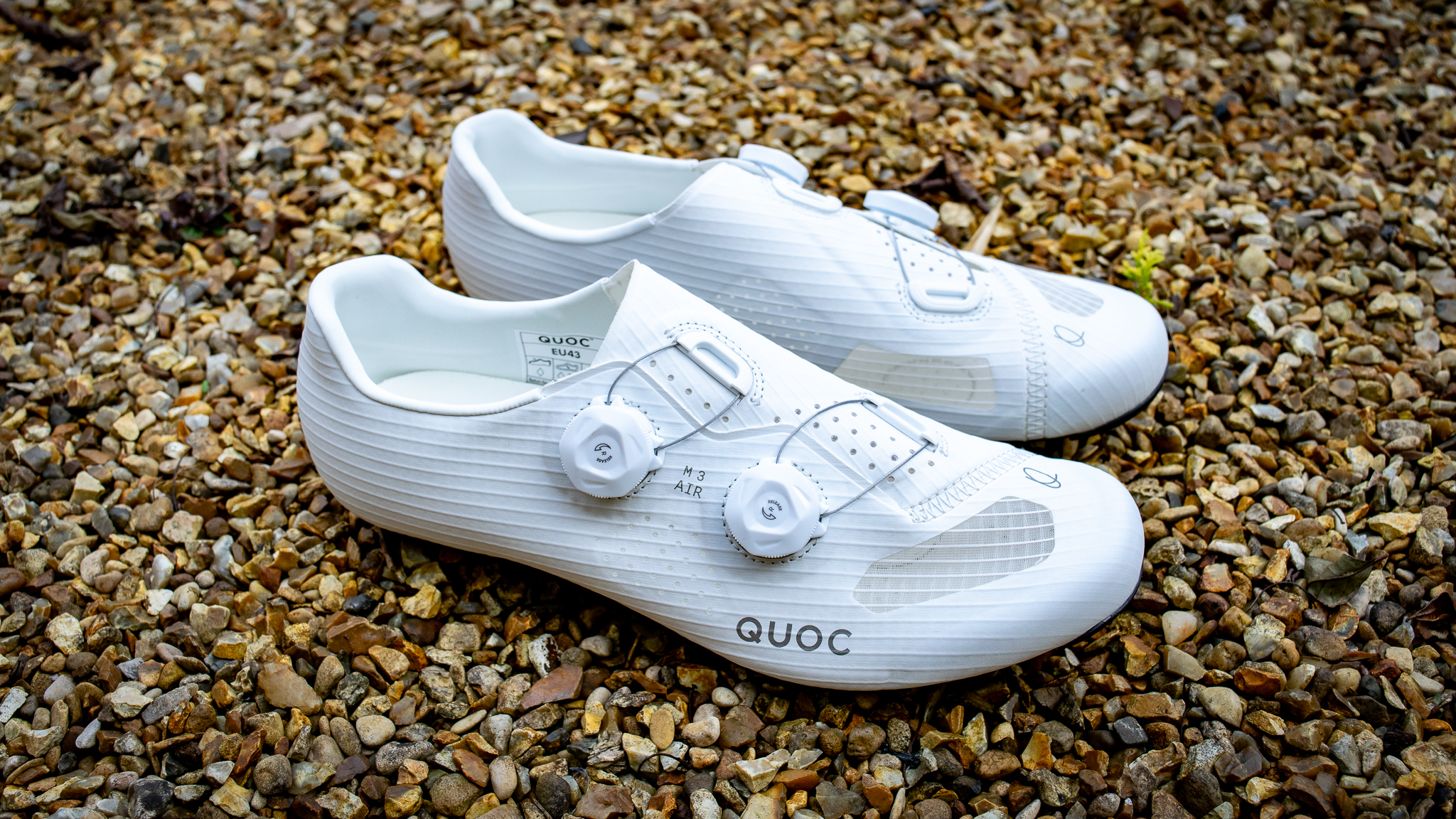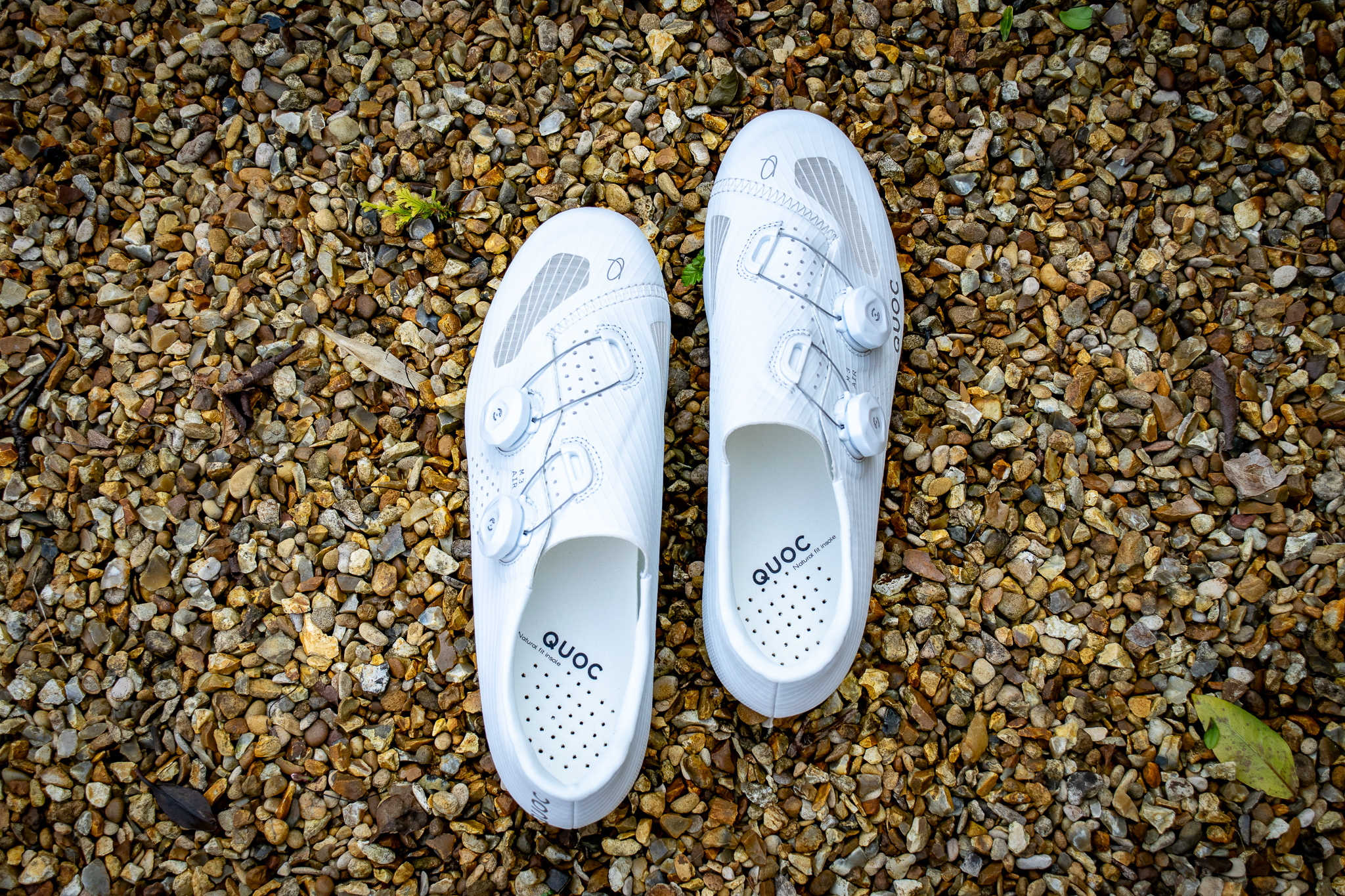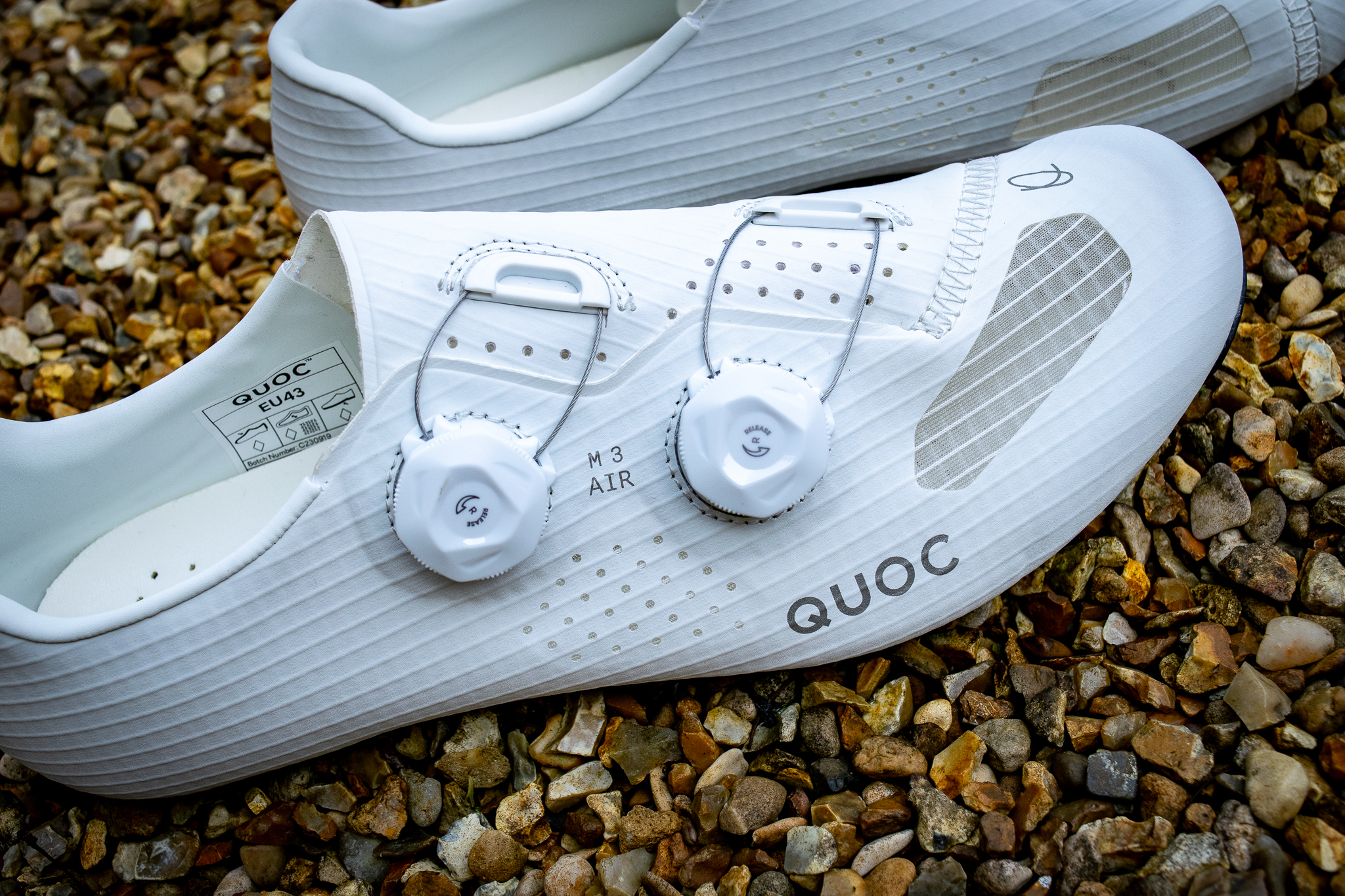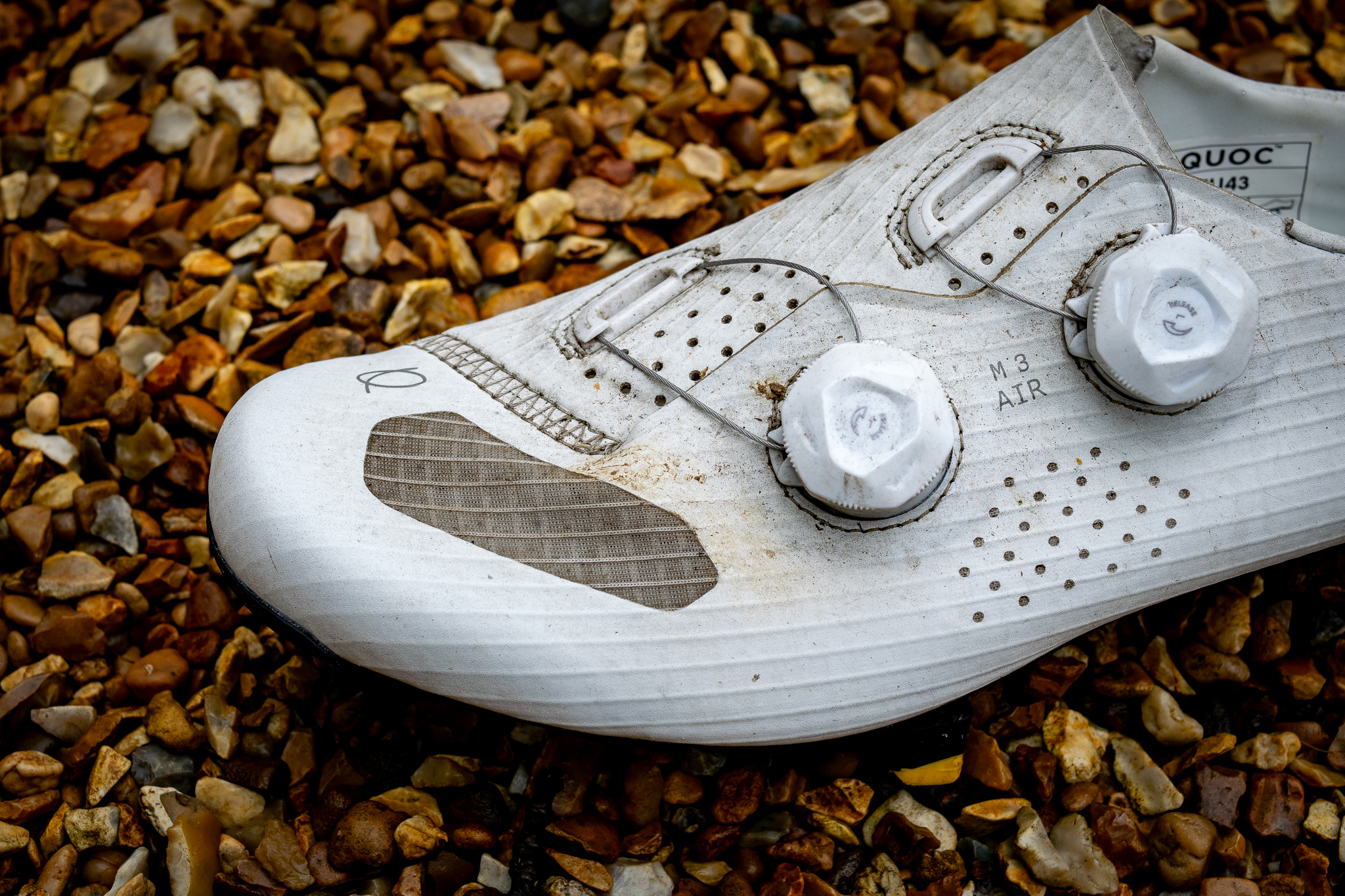
Price: £320 / $430 USD | €380 EUR
Weight: 264 grams per shoe - Size 43
Sizes: 38-47
Colour: White
Cleat Compatability: Three bolt
I reviewed the Quoc Mono II cycling shoe for my first ever piece of work with Cyclingnews back in 2022, so when Quoc announced its latest high-end road cycling shoes, the M3 Air, it seemed only fitting that I should see how they compared.
Quoc launched the shoes alongside a collaboration with Geraint Thomas in March and we first spotted the Welsh star racing in the then-unreleased pair in February.
They top the Quoc road shoe range, and feature a full carbon sole and two-piece TPU (Thermoplastic polyurethane) upper. The shoes are available in white only and carry a retail price of £320 / $430 putting them price-wise into the best cycling shoe territory.
I've been riding in the shoes for a few months now. I've used them for short spins, and hard chain gangs, in dry and soaking wet weather, as well as completing my longest-ever ride in them recently at 178 miles.
The M3 Airs seem to have gotten a fair bit of traction post-launch from Quoc's slick marketing and are being worn by several top riders including Ineos Grenadiers captain Thomas. They are a sleek, white cycling shoe lover's dream, but does the performance warrant the price tag?

Design and aesthetics
What's better on a dry, summer's day than cruising along with some crisp white cycling shoes and socks on? If you're of the same mind, the M3 Airs will be right up your street. Their sleek uppers and fairly minimal design again remind me of the words I used to describe the Mono II shoes; slipper-like.
They have a single silver 'Quoc' and 'M3 Air' and 'Q' logo and that's it. Quoc's own dual-closure dials are also white, which adds to the clean look. The shoes come with a light pink Quoc shoe bag in the box as well as three different replaceable arch supports to help riders fine-tune their fit.
Design-wise, they use the same carbon fibre sole as the Mono II. This has a single mesh vent in the forefoot and for reference, the rubber toe and heel pads have been very durable and look to be exactly the same here. Quoc also says the M3 Air was designed using a new last, which adds increased support at the ball of the foot and space in the toe box.



The M3 Air uses a two-piece TPU laminated upper which features subtle, raised horizontal lines, it is stitched together across the front of the shoe and joined at the rear. There are two large mesh vents at the front of the shoe for 'maximum aeration in high-intensity conditions'. Apparently, the point of aeration came up a lot regarding pro-rider feedback to help reduce foot swelling during races. The 'tongueless' design is also present. There isn't a traditional tongue, the shoe material wraps over the front of the foot and really aids the clean styling.
The perforated sections of the shoe you can see in the pictures feature this mesh panelling underneath which can be seen when looking inside the shoe but it's largely covered over by the upper here. Quoc has also released an all-season toe cover for the shoes' vents in less-than-ideal conditions, though I haven't tested this as yet. You can, of course, use any other toe cover but it may not cover the vents as well.
The dual shoe closure dials sit parallel to each other, a layout that reminds me of the Specialized S-Works 7 shoes. The closure wire itself appears to be coated metal wire instead of the nylon used on the Mono II and doesn't feel quite as smooth in use. Quoc told me that it had widened the lace guide to improve foot support, specifically to create fewer pressure points when sprinting and to be more responsive.
I can't say I've felt any pressure from the Mono II in over two years of constant use and think I personally prefer the Mono II system. I think this goes to show how different riders' feet are though: what works for one may not be right for another.

Performance
I've gotten on really well with the M3 Air shoes. They look great, have been comfortable from the off, fitted well enough and the carbon sole has felt stiff enough for my needs. I like the lightweight and lean construction including the wraparound tongue and they do feel light on the foot. Like everything I test, I've done plenty of riding in them and used them in anger, they haven't given me a single issue or problem.
The shoes are fairly narrow in fit, Quoc says the fit is a bit racier, I measured the sole at its widest point at around 91mm. My own feet are narrow too so this hasn't been an issue for me, but I suspect if you need a wider shoe, the M3 Air may not be perfect for you. The mesh panel on the inside of the foot will actually magnify any width issues as it's easy to see and feel your foot bone layout. Shoe fit is personal though and this is obviously going to vary between riders.
The location of the dual closure dials and coated wire doesn't feel super smooth to use in my opinion. I feel you can't tighten the shoes down quite as tightly or evenly as you might need sometimes, compared to a shoe like the Northave Veloce Extreme which you can really ratchet down. For me, the Mono II nylon wire feels a little bit lighter to use, I can feel this wearing one of each shoe to compare and I think the multiple closure points on the Mono II allow for a slightly snugger fit. Heel retention feels about the same as the Mono II for me, it's not super snug but hasn't caused me any issues, again this is a personal one.
White shoes mean cleaning and I've gotten on fine cleaning the shoes up. I've used baby wipes, non-aggressive floor wipes and a soft toothbrush with washing up liquid (dish soap) after a filthy few hours at RideLondon. The mesh panels will darken meaning they will need more than just wiping but mine came up nice and clean again after a scrub with an old toothbrush. The texture in the TPU upper does mean you need to give the shoes a decent wipe down or scrub to get them looking fresh again.
I can't honestly say I've felt a massive amount of cooling from the mesh windows though this doesn't mean it isn't happening. I've used the shoes in 20+ degrees heat and for over 10 hours of riding where my feet did stay comfortable. I've had a couple of airy moments but I can't say the M3 Airs have taken ventilation to a new level. I understand think this is going to be a pretty personal thing from rider to rider though.

Value
The M3 Air retails for £320, which is expensive however you slice it, and an increase of £50 over the Mono II. £320, however, is on a par with plenty of other premium road shoes on the market right now.
As a quick comparison, they are cheaper than the top-end Northwave Veloce Extreme and Nimbl Ultimate, a shoe favoured by lots of Thomas' WorldTour rivals currently.
The shoes do feel good, and haven't given me an ounce of trouble. I just don't know if they represent a huge improvement in performance over the Mono II for the extra £50 spent. The Mono II is being phased out I understand, so don't expect to see it around forever. Quoc did also tell me more iterations of the M3 will be launched in the future.

Verdict
I love the aesthetics the M3 Air shoes bring to the table. I don't think my dream cycling shoes would be much different if I designed them myself.
I've found the shoes to be comfortable, and have experienced zero hotspots, rubbing or discomfort of any kind and the shoes have supported my feet well when riding hard.
I think the closure dial placement and the distance between the dial and wire loop don't offer as much range of adjustment and lead to a less foot-hugging fit than some shoes. If they fit your feet and work for you I don't think you'll have an issue but if you find they are a little large volume-wise for your feet, the adjustment and retention on offer may not be enough and leave you wanting more.







